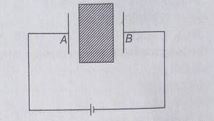Displacement current is produced between the plates of a capacitor when potential difference between the plates
is maximum
is minimum
is zero
is changing with time
The correct Answer is:D
To solve the question regarding the displacement current produced between the plates of a capacitor when the potential difference between the plates is varied, we can follow these steps:
1. Understanding Displacement Current: Displacement current is a concept introduced by James Clerk Maxwell, which accounts for the changing electric field in regions where there is no physical current flowing, such as between the plates of a capacitor.
2. Capacitor Setup: Consider a parallel plate capacitor connected to a circuit. When a potential difference (voltage) is applied across the plates, an electric field is established between them.
3. Effect of Constant Potential Difference:
- If the potential difference between the plates is constant (either maximum or minimum), the electric field between the plates remains constant as well.
- According to Maxwell's equations, if the electric field is constant, there is no change in the electric field with respect to time, which means there will be no displacement current.
4. Effect of Zero Potential Difference:
- If the potential difference is zero, there is no electric field established between the plates. Thus, there is no displacement current in this case either.
5. Changing Potential Difference:
- If the potential difference is changing with time, the electric field between the plates will also change.
- A changing electric field induces a displacement current, according to Maxwell's addition to Ampere's law. This means that when the potential difference varies, the displacement current is produced.
6. Conclusion: Therefore, the displacement current is produced between the plates of a capacitor when the potential difference between the plates is changing with time.
Final Answer:
Displacement current is produced when the potential difference between the plates is changing with time.
---
- If the potential difference between the plates is constant (either maximum or minimum), the electric field between the plates remains constant as well.
- According to Maxwell's equations, if the electric field is constant, there is no change in the electric field with respect to time, which means there will be no displacement current.
- If the potential difference is zero, there is no electric field established between the plates. Thus, there is no displacement current in this case either.
- If the potential difference is changing with time, the electric field between the plates will also change.
- A changing electric field induces a displacement current, according to Maxwell's addition to Ampere's law. This means that when the potential difference varies, the displacement current is produced.
Displacement current is produced when the potential difference between the plates is changing with time.
Topper's Solved these Questions
- BOOK - MODERN PUBLICATIONCHAPTER - ELECTROMAGNETIC WAVESEXERCISE - COMPETITION FILE - OBJECTIVE TYPE QUESTIONS ( MULTIPLE CHOICE QUESTIONS )(B )40videos
ELECTROMAGNETIC WAVES
- BOOK - MODERN PUBLICATIONCHAPTER - ELECTROMAGNETIC WAVESEXERCISE - COMPETITION FILE - OBJECTIVE TYPE QUESTIONS ( MULTIPLE CHOICE QUESTIONS )(C )5videos
ELECTROMAGNETIC WAVES
- BOOK - MODERN PUBLICATIONCHAPTER - ELECTROMAGNETIC WAVESEXERCISE - REVISION EXERCISES ( NUMERICAL PROBLEMS )8videos
ELECTROMAGNETIC WAVES
- BOOK - MODERN PUBLICATIONCHAPTER - ELECTROMAGNETIC INDUCTIONEXERCISE - CHAPTER PRACTICE TEST FOR BOARD EXAMINATION14videos
ELECTROMAGNETIC INDUCTION
- BOOK - MODERN PUBLICATIONCHAPTER - ELECTROSTATIC POTENTIAL AND CAPACITANCE EXERCISE - Chapter Practice Test9videos
ELECTROSTATIC POTENTIAL AND CAPACITANCE
Similar Questions
In order to establish an instantaneous displacemet current of 1 mA in the space between the plates of 2μF parallel plate capacitor, the potential difference need to apply is
View SolutionDisplacement current goes through the gap between the plates of a capacitor when the charge of the capacitor
View Solution
Knowledge Check
- Question 1 - Select One or More
Displacement current exists between the plates of capacitor , when charge of the capacitor
Aremains constantBincreaseCdecreasesDzero - Question 2 - Select One
Displacement current exists between the plates of capacitor , when charge of the capacitor
AConstantBMaximumCChangingDBoth (1) &(3) - Question 3 - Select One
The plates of a capacitor are charged to a potential difference of 320 volt and are then connected across a resistor. The potential difference across the capacitor decays exponentially with time. After 1 sec the potential difference between the plates of the capacitor is 240 volts. what is the potential difference between the plates after 2 s?
A200 VB180 VC160 VD140 V
To establish an instantaneous displacement current of 2A in the space between two parallel plates of 1μF capacitor, the potential difference across the capacitor plates will have to be changed at the rate of
View SolutionA capacitor is charged to a potential difference of 100 V and is then connected across a resistor. The potential difference across the capacitor decays exponentially with respect to time. After 1 sec, the P.D. between the plates of the capacitor is 80 V. what will be the potential difference between the plates after 2 sec ?
View SolutionAn insulator plate is passed between the plates of a capacitor the current
 View Solution
View SolutionAn insulator plate is passed between the plates of a capacitor the current
 View Solution
View SolutionFor uniform electric field, potential difference between the plate is
View Solution

